How Soil Sensors Work with Cloud Irrigation
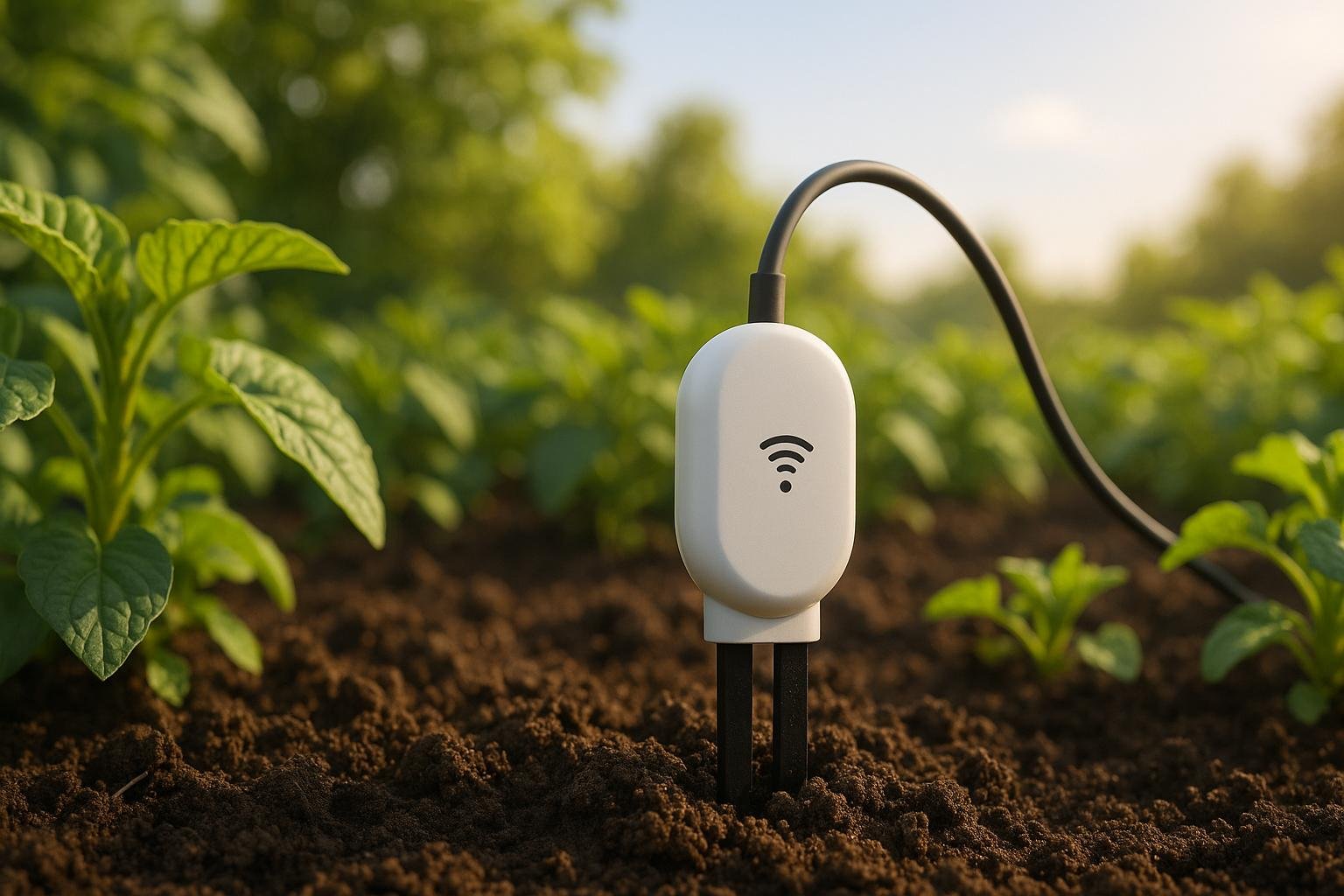
Soil sensors paired with cloud irrigation systems are transforming how we manage watering for plants. Here's the gist: soil moisture sensors measure how much water is in the soil, while cloud-based systems analyze this data to automate watering schedules. This combination ensures plants get just the right amount of water, saving resources and promoting healthier growth.
Key Points:
- How It Works: Sensors detect soil moisture levels, send data to the cloud, and trigger irrigation only when needed.
- Types of Sensors:
- Volumetric Water Content (VWC): Measures water volume in soil.
- Soil Water Tension: Measures the effort plants need to extract water.
- Cloud Features: Remote monitoring, weather-based adjustments, and mobile control.
- Benefits: Reduces water use by 15–50%, saves costs, and improves plant care.
- Costs: Initial setup ranges from $1,300–$4,000; annual data plans cost $150–$350.
This tech isn't just for large farms - homeowners can also enjoy the convenience and savings of smart irrigation. With proper setup, you can ensure efficient water use and healthier plants, all while monitoring and controlling your system from anywhere.
Soil moisture monitoring, irrigation and fertigation

How Soil Sensor Integration Works
The integration of soil sensors with cloud-based irrigation systems involves three key elements: hardware, data transmission, and automated responses. Together, these components create an intelligent watering system that adapts to real-time soil conditions.
Hardware: Sensors, Controllers, and Connectivity
At the heart of any cloud-connected irrigation system are soil moisture sensors. These devices measure moisture levels and temperature in the soil [4]. They connect to microcontrollers, such as the ESP32 - a cost-effective and high-performance IoT module [8] - which processes the sensor data for transmission.
Wireless communication modules then facilitate the transfer of this data from sensors to the cloud. For instance, LoRa modules can transmit data over long distances, up to about 3,280 feet (1,000 meters), while WiFi modules are effective within a range of around 492 feet (150 meters) [4]. Depending on their range and capabilities, gateways for this data transfer can cost between $399 and $2,250 [6]. Once the data is collected, it’s sent to the cloud using cellular modems or internet connections.
Irrigation controllers play a crucial role in this system. They receive commands from the cloud platform and manage tasks like controlling valves, activating pumps, and regulating water flow based on the analysis performed in the cloud.
The system’s flexibility is enhanced by various connectivity configurations, as shown below:
| Connectivity Type | Description |
|---|---|
| Chorded to LoRaWAN wireless device | Sensor connects to a LoRaWAN transmitter via a cable [6] |
| Aboveground LoRaWAN wireless | Transmitter is integrated into the aboveground sensor housing [6] |
| Wireless connection | Underground sensors with above-ground solar-powered transmitters [6] |
| Chorded to data logger with wireless device | Underground sensors linked to dataloggers equipped with transmitters [6] |
With the hardware in place, the next step is understanding how this data moves from sensors to the cloud.
How Data Flows from Sensors to the Cloud
Once the soil sensors capture real-time data on moisture, temperature, and humidity, they transmit it wirelessly to a base station or gateway using radio frequency signals [4].
The base station then uploads this information to cloud servers via cellular modems or other internet connections [5]. Data plans for these transmissions typically cost between $150 and $350 annually for all sensors, or $2 to $550 per sensor annually, depending on the system and data usage [6].
In the cloud, algorithms process the sensor data alongside weather forecasts, plant requirements, and historical trends [11]. This analyzed data becomes accessible to users through web dashboards or mobile apps, providing real-time monitoring and insights. Additionally, machine learning algorithms refine irrigation predictions over time, improving system efficiency.
Automated Watering: From Analysis to Action
When the cloud-based analysis identifies the need for irrigation, it sends commands to the irrigation controllers [4]. These controllers ensure watering happens only when soil moisture levels drop below specific thresholds. When this occurs, the system activates water pumps and opens irrigation valves to deliver the necessary water [6].
Mike Boekholder, Director of Field Operations for The Phillies at Citizens Bank Park, highlights the accuracy these systems bring:
"They've exceeded my expectations… It's no longer guesswork - it's science. We're watering with more precision, and managing turf and clay has never been easier." [5]
The benefits of such precision are evident. For example, a LoRaWAN-based irrigation system in a 22-hectare olive grove in Greece reduced water usage by 42% in 2020 and by 25% in 2021, thanks to multi-depth soil moisture monitoring [7]. Another study reported a 30% reduction in water consumption while maintaining ideal soil moisture levels through real-time sensor data and automated controls [10].
Beyond watering, these systems also provide real-time alerts to users, notifying them of irrigation events, maintenance needs, or unusual conditions [11]. This integration showcases how smart technology can transform garden and agricultural care for greater efficiency and sustainability.
Setting Up Soil Sensors with Cloud Irrigation Systems
Getting your soil sensors connected to a cloud-based irrigation system can seem complex, but breaking it into clear steps makes it manageable. This involves picking the right sensors, installing them carefully, and setting up the cloud software to match your garden's needs.
Choosing the Right Soil Sensors
Soil sensors come in two main types: single-depth and multi-depth. Single-depth sensors typically cost between $100 and $700, while multi-depth sensors, which collect data from multiple layers, range from $600 to $1,750 [6].
When selecting sensors, think about the type of data you need. Make sure the probe is long enough to reach your plants' rooting depth. Keep in mind that soil texture can influence performance. For example, capacitance sensors are better for saline conditions but need frequent calibration, while granular matrix sensors work well in medium to fine soils but might struggle in sandy environments [1].
"Monitoring soil moisture content is a critical aspect of effective irrigation scheduling. Maintaining optimal soil moisture levels is essential for plant growth and crop yield." [6]
Durability is another factor. Look for sensors with high IP ratings to resist water and dust. Battery life varies widely - some sensors last much longer than others. Also, consider how far the sensors need to communicate with the base station. LoRa transmitters are ideal for long distances, while WiFi modules work better for shorter ranges [4].
Once you've chosen your sensors, the next step is proper installation and calibration to ensure they deliver accurate results.
Installing and Calibrating Sensors
Getting the installation right is critical. Misplacing sensors can skew readings by more than 10% [12]. Before you start, test the sensors in various soil types to understand their behavior and spot any potential issues.
For accurate readings, ensure the sensor has strong contact with the soil. The area right next to the probe is the most influential for data accuracy [12]. Avoid disturbing the soil too much during installation, and make sure no air gaps form around the sensor.
Place sensors at depths that match your plants' rooting zones. Research indicates that most crops begin experiencing stress when soil water depletion hits 30–50% of the available water holding capacity [1]. Protect sensor cables by enclosing them in PVC pipe, wire loom, or flexible conduit [12]. Clearly mark sensor locations for easy access during maintenance.
After installation, check the sensor readings before burying the cables completely to confirm they are working correctly [12]. Calibration is also crucial, as even sensors of the same model can have variations. Follow the manufacturer's instructions for calibration, adjusting for your specific soil conditions [13].
With installation and calibration complete, you're ready to integrate the sensors into your cloud-based irrigation system.
Configuring Cloud-Based Irrigation Software
Once your sensors are up and running, it's time to set up the cloud software to automate watering based on real-time data. Start by ensuring your sensors are compatible with your irrigation system. The sensor's output must align with the system's input requirements [14]. Use data converters or repeaters if needed to establish a clear communication link [14].
Set moisture thresholds tailored to your plants' water needs and soil type. These thresholds, measured as volumetric water content (VWC) or soil water tension, trigger the system to start watering [9]. You can also configure stop conditions, such as reaching a target soil moisture level, delivering a specific amount of water, or running for a set time [9].
Data plans for cloud-based systems vary, costing between $150 and $350 annually for a system or $2 to $550 per sensor per year [6]. Enable remote access through mobile apps or web dashboards to monitor soil conditions, tweak schedules, and get alerts for unusual events like sensor malfunctions or extreme moisture levels.
Before fully relying on the system, run manual irrigation cycles to test its functionality. Check that the data transmission is accurate and the stop conditions work as intended. As Vasudha Sharma explains:
"One of the easiest and most effective ways to improve irrigation efficiency is to implement soil sensor technology in irrigation scheduling." [1]
Finally, create a feedback loop where the system adjusts based on real-time soil data. This ensures your irrigation becomes more efficient over time, using water wisely and keeping your plants healthy.
sbb-itb-4d6a8dd
🚀 Ready to Reinvent Your Garden?
Join thousands of homeowners who have transformed their gardens using our AI design tool. Upload one photo to explore endless possibilities.
Get your AI garden designs →Pros and Cons of Cloud-Integrated Soil Sensor Systems
Cloud-integrated soil sensors offer a mix of benefits and challenges. By weighing both sides, you can decide if they're the right fit for your gardening needs.
Pros: Efficiency, Savings, and Smarter Decisions
These systems shine when it comes to saving water, cutting costs, and providing actionable insights.
Water conservation is a standout benefit. Smart irrigation systems, when paired with soil moisture sensors, can cut water usage by up to 50% [3]. Not only does this help the environment, but it also lowers your water bill.
Studies back this up. Research from Clemson University found that soil moisture sensors could increase net income by 20% through better irrigation practices [15]. While the study focused on commercial farms, many home gardeners report recouping their investment within two years [3].
Real-world examples reinforce these savings. In Italy, pear orchards equipped with six soil sensors reduced water use by 50% [15]. Similarly, an Italian strawberry grower saved over $700 per hectare by using a moisture probe to avoid overwatering [15].
Data-driven insights take the guesswork out of watering. By measuring soil moisture at different depths, you can fine-tune your irrigation schedule for healthier plants and better yields.
The convenience is undeniable. With remote monitoring, you can check soil conditions, adjust watering schedules, and get alerts - all from your phone. This means your plants get the care they need, even if you’re not home.
Cons: Costs, Connectivity, and Maintenance
As appealing as these systems are, they come with some hurdles.
High upfront costs can deter many homeowners. Setting up a real-time sensor system, including a data logger and three soil moisture sensors, typically costs between $1,300 and $4,000 [19]. Individual sensors range from $30 to $100, while advanced models can cost $100 to $300 or more [17].
Then there are the ongoing expenses. Cellular data subscriptions for data loggers range from $60 to $180 annually [19], and cloud-based analytics can add over $1,500 in yearly fees [18].
Connectivity issues are another challenge, especially in rural areas where stable internet access may be unreliable. If the connection drops, automated irrigation systems might fail, leaving plants without water.
The technical complexity of these systems can also be daunting. Integrating data from different devices often requires advanced analytics, and compatibility issues between various manufacturers’ protocols can make setup tricky [16].
Maintenance is an ongoing task. Sensors must withstand harsh conditions like moisture and temperature changes, which means regular calibration, battery replacements, and software updates are necessary to keep everything running smoothly [16].
Lastly, security risks shouldn’t be overlooked. IoT devices can be vulnerable to hacking, potentially disrupting operations or compromising your data [16]. Protecting your system and personal information requires constant vigilance.
How AI Enhances Predictive Irrigation
While these challenges exist, AI is helping to address many of them by making irrigation smarter and more precise.
AI analyzes a mix of data - soil moisture levels, weather forecasts, plant growth stages, and historical trends - to optimize watering schedules automatically. This prevents both overwatering and drought stress by adjusting irrigation based on predicted weather and plant needs.
As AI systems process more data, they become better at adapting to your garden’s unique conditions, such as soil drainage and seasonal changes. For example, platforms like AIGardenPlanner use sensor data to create custom irrigation zones, ensuring each part of your garden gets the right amount of water.
AI also offers early warnings. By spotting subtle changes in soil moisture, it can flag potential issues like drainage problems before they become serious. This proactive approach helps you address problems early, saving time and effort.
With precision agriculture technologies becoming more common, even home gardeners are adopting these tools. By 2022, over 40% of U.S. corn and soybean farms were already using some form of precision agriculture [18], signaling a growing trend toward smarter, more efficient water management solutions.
Remote Monitoring and Control: Practical Uses
The real advantage of cloud-connected soil sensors is the freedom to manage your irrigation system from virtually anywhere. These systems let you take full control of your garden, no matter where life takes you.
Real-Time Monitoring and Alerts
With cloud-connected soil sensors, your smartphone becomes your irrigation command center. You can check moisture levels, track water usage, and get instant updates on your system’s status, all in real time.
The alert system stands out by notifying you about potential issues - like sensor malfunctions, leaks, or irrigation line breaks - before they escalate into costly problems [24]. Many platforms ensure you stay informed through multiple channels, such as app notifications, text messages, or even phone calls.
Some users have found creative ways to make these alerts even more effective. For instance, Felipe Rodríguez’s team at Agricola Santa Inés de Chile receives irrigation notifications directly through WhatsApp, ensuring everyone knows exactly when action is needed [23].
"Everything is now on my phone, and my entire team receives irrigation alerts through WhatsApp."
– Felipe Rodríguez, Agricola Santa Inés de Chile [23]
These timely alerts help you avoid overwatering or underwatering, which not only saves water but also promotes healthier plants and better crop yields [22].
Kyle Stauber, Head Grower at McIntyre Creek Cannabis, highlights how remote monitoring provides peace of mind:
"Verdi has greatly improved my efficiency and confidence by allowing remote monitoring of pressure, flow, and valve operation, ensuring everything runs smoothly and sending me an alert when there is an issue."
– Kyle Stauber, Head Grower, McIntyre Creek Cannabis [24]
This level of precision ensures your irrigation system is always operating at its best.
Adjusting Irrigation Schedules Remotely
Beyond just monitoring, cloud platforms allow you to adjust watering schedules on the go. Whether it’s an unexpected weather change or a last-minute trip, you can modify your irrigation plans with ease. This flexibility ensures your plants get the right amount of water, no matter how unpredictable your day becomes.
These systems pull data from soil moisture sensors, weather stations, and even satellite imagery to help you make informed decisions [21]. For example, if rain is in the forecast, you can pause your irrigation schedule instantly. Planning a weekend getaway? Adjust watering times to keep your garden thriving while you’re away.
By connecting soil sensors to automated controllers linked with cloud-based software, you can monitor and control everything from your smartphone, tablet, or computer [21]. AI-driven tools analyze the data to suggest optimized schedules, taking the guesswork out of irrigation management [21]. Systems like Mottech’s IRRInet combine real-time monitoring, weather data, and soil moisture readings to deliver precise watering routines [21].
For the best results, place sensors at various depths in key areas of each irrigation zone. Input your crop’s water needs and integrate weather forecasts to let the system fine-tune schedules automatically, all while prioritizing water conservation [20].
Integration with Smart Home Systems
Cloud irrigation systems don’t just stop at remote monitoring - they can also integrate seamlessly with smart home platforms, offering a unified approach to home automation. In the U.S., these systems work with popular smart home ecosystems, creating a connected experience that ties your garden care to the rest of your automated routines.
Many platforms provide API access, letting you create custom workflows or automate device management to suit your needs [20]. Intuitive dashboards make it easy to monitor and manage everything from your connected devices [20].
Reliable wireless or IoT connections are key for accurate sensor readings and automatic controls [20]. Most systems rely on cellular data, but some also use your home’s Wi-Fi network for basic functions.
This integration goes beyond simple watering schedules. Your irrigation system can sync with weather apps, adjust settings when your smart home enters vacation mode, or even respond to voice commands. For example, you could check your garden’s status alongside other smart home notifications or tweak irrigation settings with a simple voice request. By linking irrigation to your broader home automation, you create a more efficient and convenient system that works seamlessly with your lifestyle.
Conclusion
Pairing soil moisture sensors with cloud-based irrigation systems offers a smart approach to modern gardening and agriculture. These systems can cut water use for landscape irrigation by up to 50%, with WaterSense-labeled soil moisture sensors alone saving more than 15,000 gallons of water annually for homes equipped with automatic irrigation systems [26][2]. On a national scale, this technology has the potential to conserve over 390 billion gallons of water each year, while also reducing runoff and limiting the leaching of fertilizers and pesticides into nearby waterways [2][25].
The benefits go beyond just water savings. By keeping soil moisture at optimal levels, these systems encourage healthier plant growth, reduce labor through automation, and provide actionable data to help gardeners make smarter decisions [25].
Environmentally, these systems also play a role in enhancing water quality and reducing chemical runoff. By preventing overwatering, they help curb nutrient leaching, which protects local water sources from contamination [25].
To take these advantages even further, integrating smart garden design tools can maximize the efficiency of these systems. For example, AIGardenPlanner offers AI-driven tools to design gardens tailored to your location, climate, and preferences. Its personalized plant recommendations ensure that you’re growing the right plants in the best spots, making your smart irrigation system even more effective by delivering precise care to each part of your garden. Together, intelligent design and sensor-based irrigation create a seamless solution for optimal garden maintenance.
Whether you’re tending to a cozy backyard or managing a larger landscape, combining soil sensors, cloud-based irrigation, and smart planning tools helps you save water, cut costs, and nurture healthier plants - all while making garden care easier and more efficient.
FAQs
How do soil sensors and cloud-based irrigation systems improve garden watering?
Soil sensors paired with cloud-based irrigation systems offer a smart way to manage watering in your garden. These sensors monitor real-time soil conditions, like moisture levels and temperature, and wirelessly send the data to a cloud platform. From there, the system evaluates the information and adjusts watering schedules and amounts to match your garden's exact needs.
This setup not only helps save water but also minimizes waste while ensuring your plants receive the perfect amount of hydration. By responding to the soil's current state, you can keep your garden thriving with less effort and greater efficiency.
How can using cloud-connected soil sensors save costs and benefit the environment?
Cloud-connected soil sensors can cut your water usage by as much as 70%. That means lower water bills and reduced energy expenses. These systems work by supplying water precisely when and where it's needed, avoiding overwatering and ensuring irrigation is as efficient as possible.
On top of saving money, these sensors are great for the environment. They conserve water, reduce soil erosion, and prevent nutrient runoff, which keeps soil healthy and safeguards nearby ecosystems. It's a win-win for your budget and the planet.
What should I consider when choosing and installing soil sensors for a cloud-based irrigation system?
When picking soil sensors for a cloud-based irrigation system, focus on reliability, accuracy, and durability. Opt for sensors with advanced connectivity features, such as Long Range (LoRa), to guarantee smooth and consistent data transmission. It’s also a good idea to choose models that are user-friendly and built to withstand long-term outdoor use.
When installing the sensors, make sure to place them at the correct depth to monitor the root zone - usually between 6 inches and 60 inches, depending on the type of plants you're growing. Place them in areas that reflect typical soil conditions, steering clear of spots where water tends to pool or drain excessively. Don’t skip calibration - it’s essential for getting precise readings and ensuring your irrigation system performs at its best.
By selecting and installing your soil sensors thoughtfully, you can improve the efficiency of your cloud-based irrigation system, helping your plants thrive while minimizing water waste.
🎨 Visualize Your Dream Garden Today!
Transform any outdoor space into a professional landscape design in minutes. Just upload a photo, choose your style, and let our AI do the rest.
Start your garden transformation now →Related posts
Related Articles
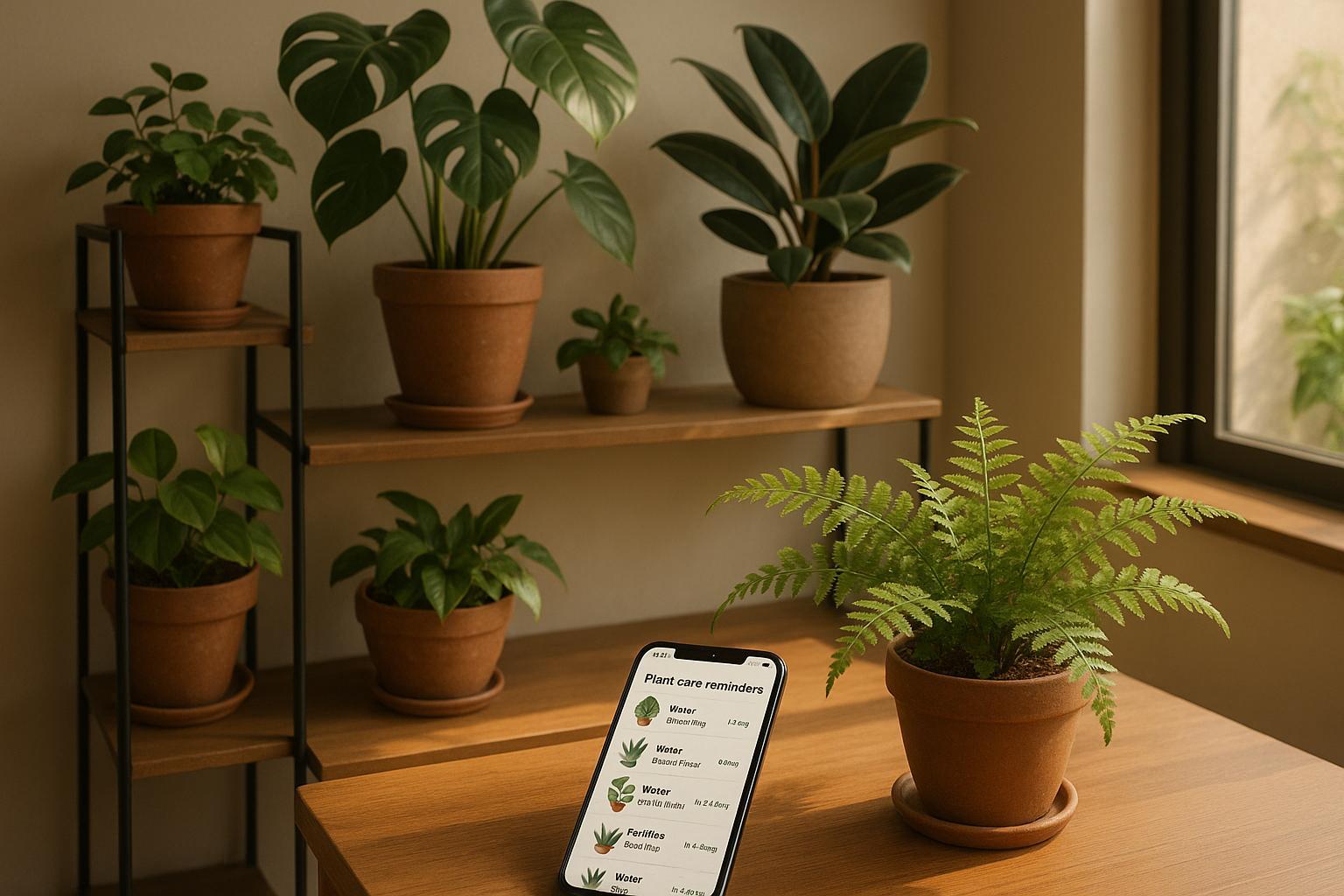
Top 5 AI Apps for Plant Care Reminders
Explore the top 5 AI apps that simplify plant care with personalized reminders, health diagnostics, and tailored advice for every gardener.
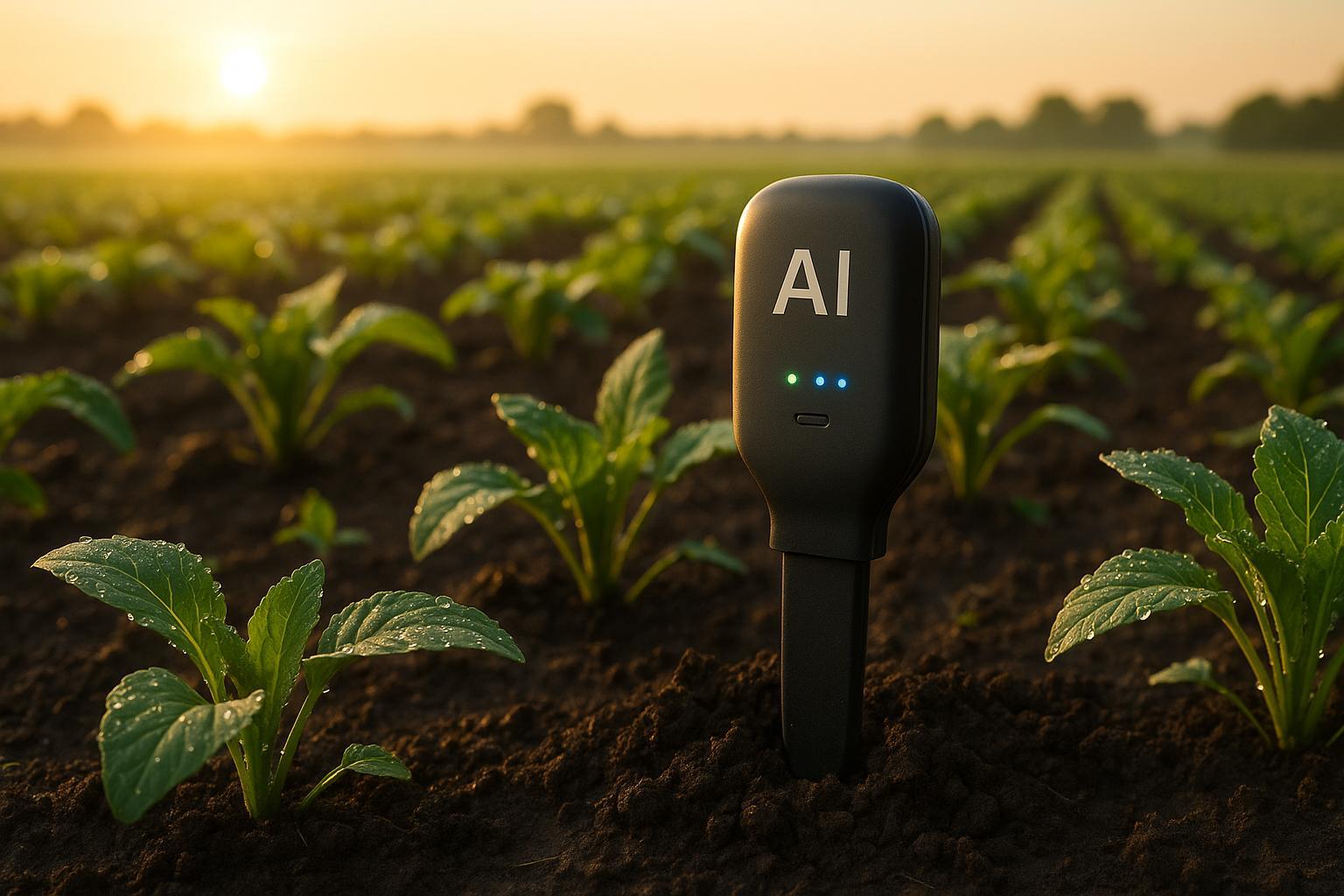
How AI Soil Sensors Monitor Moisture and Nutrients
Explore how AI soil sensors enhance farming efficiency by monitoring moisture and nutrients, optimizing irrigation, and boosting crop yields.
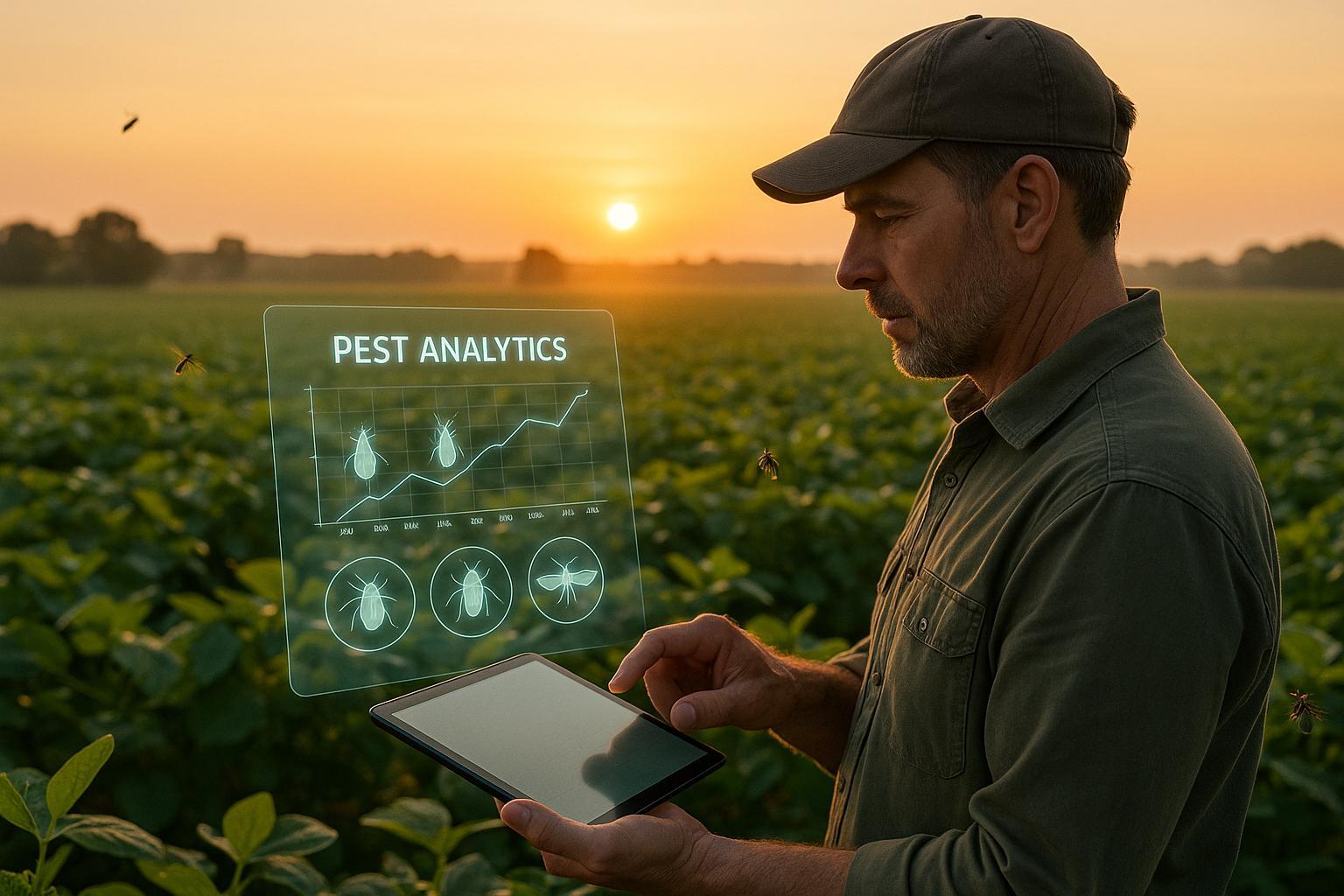
Real-Time Pest Analytics for Seasonal Yields
Explore how real-time pest analytics revolutionizes farming by enhancing yields, reducing pesticide use, and promoting sustainable practices.
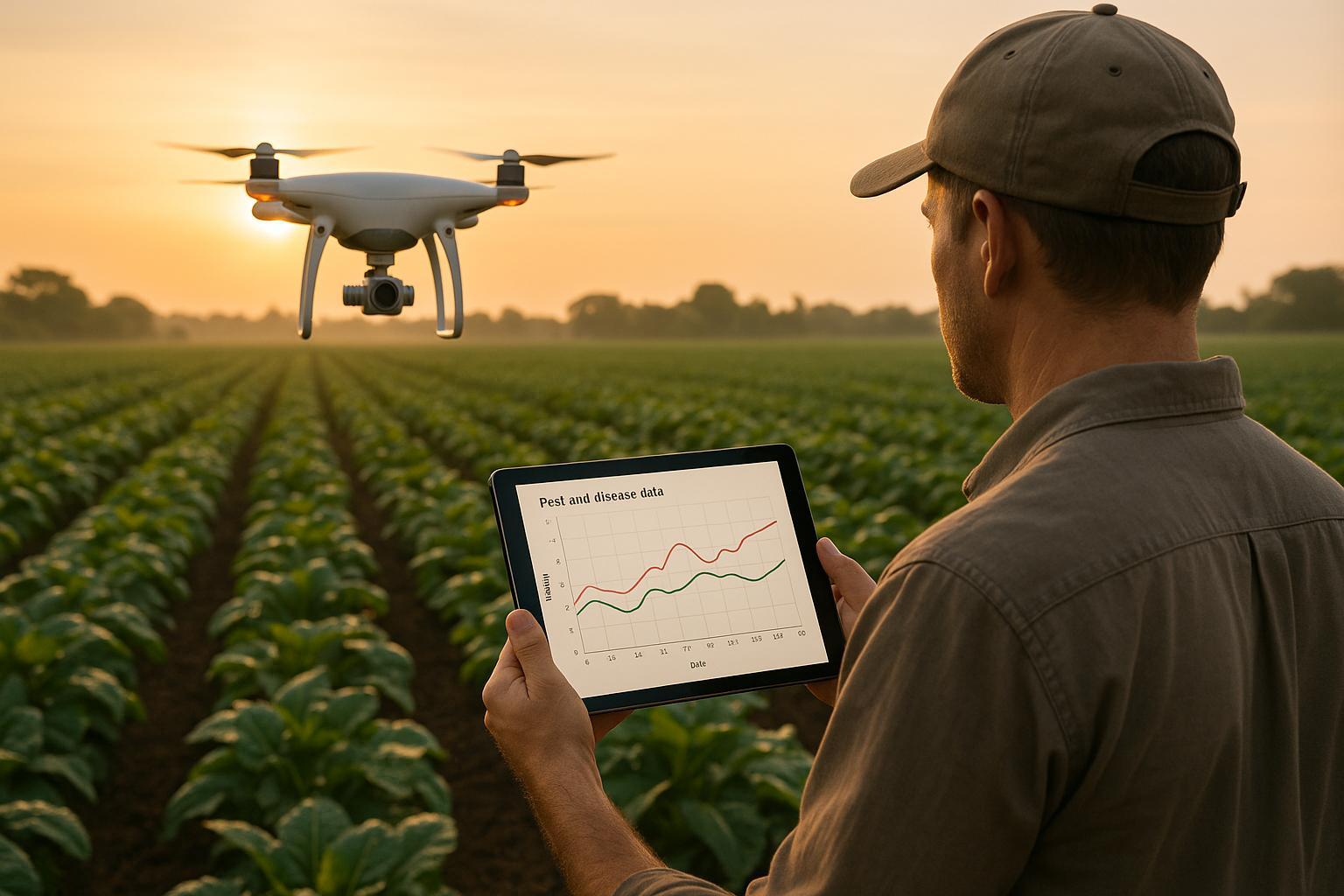
Top 7 AI Tools for Pest and Disease Management
Explore how AI tools are revolutionizing pest and disease management in agriculture, enhancing efficiency and sustainability for farmers and gardeners.
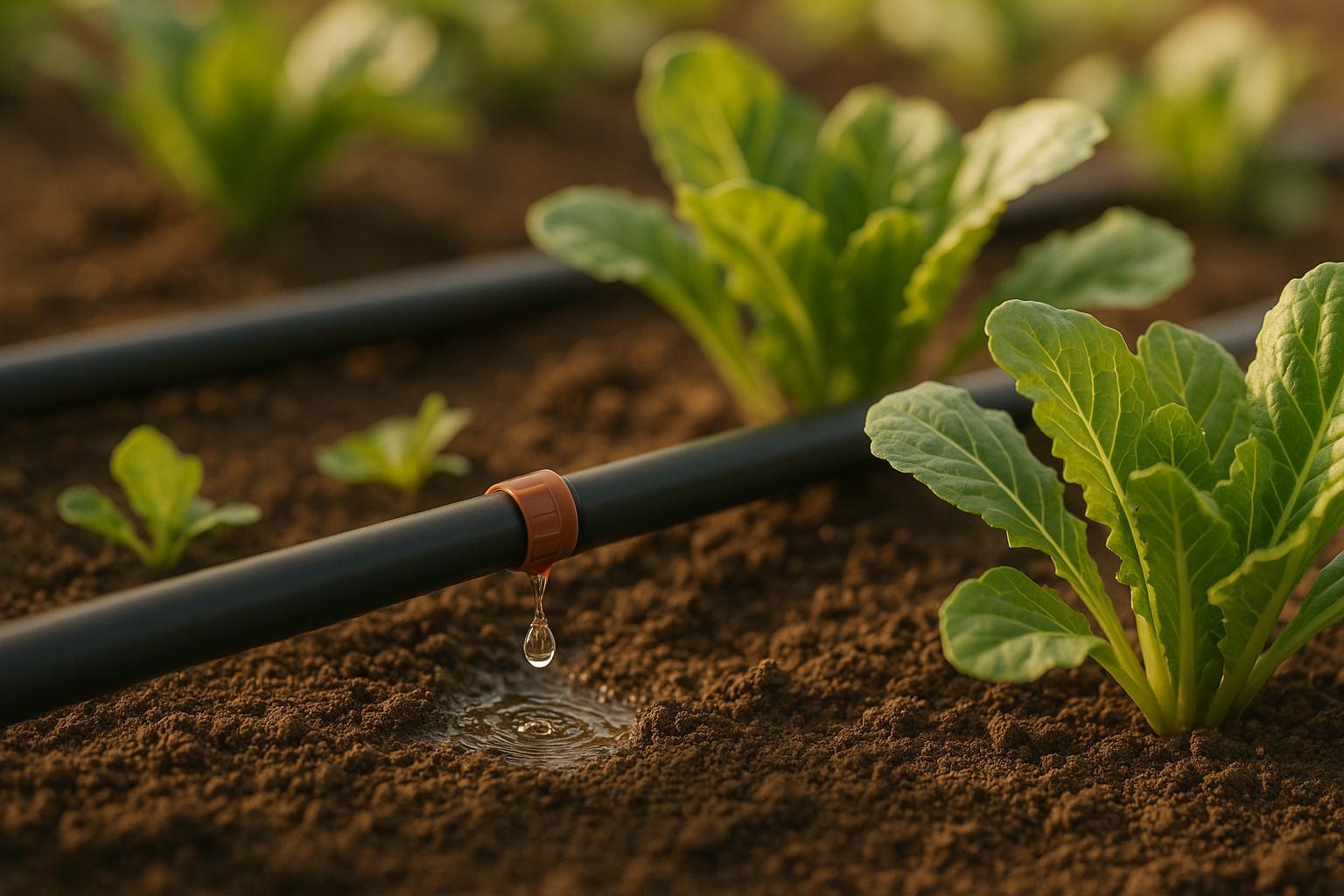
Preventing Algae in Drip Systems: Best Practices
Learn how to prevent algae growth in drip irrigation systems with effective strategies and maintenance practices that protect your plants and water flow.

Effective Methods to Get Rid of White Moths in Your Garden
Learn how to identify, prevent and get rid of white moths in your garden. Protect your plants and improve yields with these effective methods.